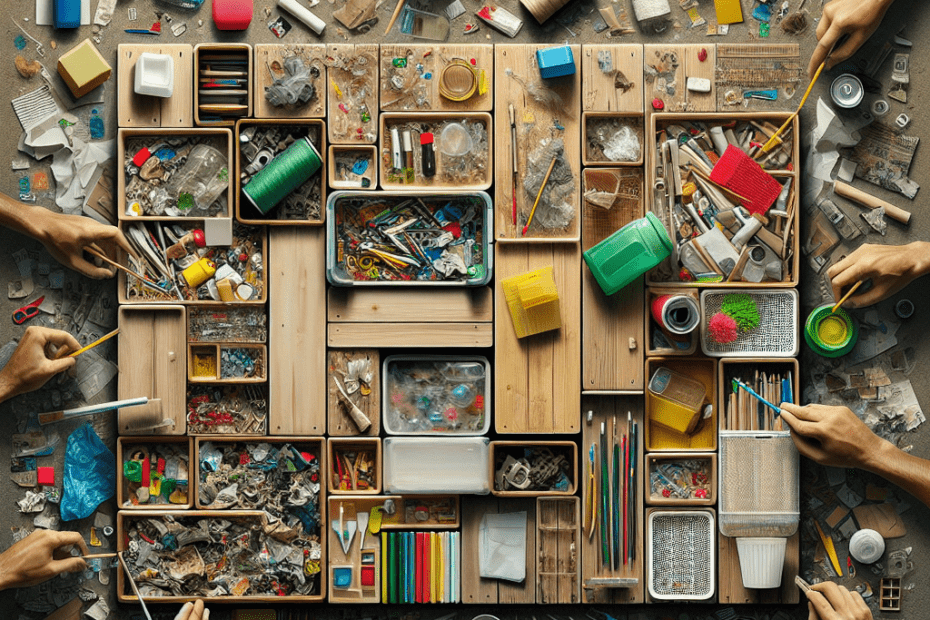### Introduction
In today’s world, environmental sustainability is no longer just an option—it is a necessity. More families are increasingly turning to creative and eco-friendly solutions to declutter their homes. One trending idea is creating a DIY Wall Organizer from recycled materials. This not only helps manage household chaos but also contributes positively to the environment. According to the Environmental Protection Agency (EPA), recycling and composting prevented about 186 million metric tons of CO2 equivalent emissions in 2018. By building organizers from recycled materials, people not only combat climate change but also unleash their artistic skills in crafting personalized wall organizers.
### Materials Required
Before embarking on this eco-friendly journey, they need a gamut of recycled materials and tools to get started. Here’s a list of items typically used:
| Item | Quantity Needed |
|———————-|————————–|
| Cardboard Boxes | 2-3 pieces |
| Old Magazines | 5-6 magazines |
| Wine Corks | 10-15 corks |
| Fabric Scraps | As needed (Various sizes)|
| Plastic Bottles | 4-5 bottles |
| Scissors | 1 pair |
| Glue Gun | 1 |
| Paint & Brushes | Optional |
### Step-by-Step Guide to Creating the DIY Wall Organizer
1. **Planning the Layout:**
The first step is to visualize how the organizer will appear. By sketching a quick plan on paper, they can decide the number of compartments needed, the arrangement pattern, and any aesthetic features.
2. **Cutting the Cardboard:**
Cut the cardboard boxes into various shapes and sizes according to the sketch. This will serve as the base of the wall organizer. Generally, rectangles and squares are versatile and can be easily assembled.
3. **Covering With Old Magazines & Fabric:**
Use pages from magazines to cover each cardboard piece, giving them an artistic flair. Alternatively, fabric scraps can also be glued onto the cardboard for more texture and color diversity. This step transforms discarded materials into visually appealing bases.
4. **Attaching Corks and Plastic Bottles:**
Attach wine corks vertically to one section of the organizer to hang keys, light accessories, or even pin notes. Cut the plastic bottles in half and secure them to another section. These can act as holders for pens, pencils, and other small items.
5. **Assembly:**
After decorating the individual pieces, they are assembled into the desired layout using a glue gun. Ensure a firm hold by pressing down each connection point for a few seconds.
6. **Painting:**
If preferred, they can personalize the organizer further with a splash of paint. Choose colors that match the room’s decor to create harmony.
7. **Mounting:**
Lastly, attach the finished wall organizer on a sturdy wall. Use nails or double-sided tape depending on the weight of the organizer. Verify that it is secure before adding items.
### Key Takeaways
– A DIY Wall Organizer from recycled materials is cost-effective, eco-friendly, and chic.
– Essential materials include cardboard boxes, old magazines, wine corks, and plastic bottles.
– The design process involves creativity, from planning the layout to decorating with paint.
– Utilizing recycled items emphasizes the importance of sustainability and environmental conservation.
– Crafting enhances one’s ability to transform everyday items into functional pieces.
### FAQs
1. **What recycled materials work best for a DIY wall organizer?**
Cardboard, old magazines, wine corks, plastic bottles, and fabric scraps are excellent materials for this project.
2. **Where can they find recycled materials?**
Materials can be collected from household items no longer in use or sourced from community recycling centers.
3. **How sturdy is a wall organizer made from recycled materials?**
When properly assembled, DIY organizers are surprisingly sturdy and can support lightweight items like stationery and keys.
4. **Can they enhance the organizer’s appearance further?**
Yes, using paint, fabric, or even additional decorations like beads can enhance the aesthetic appeal.
5. **What tools are essential for assembling the organizer?**
Key tools include scissors, a glue gun, and optional items like paint brushes.
Through this DIY venture, not only do individuals create a functional home accessory, but they also offer another life to items that might otherwise end up in a landfill. Building a DIY Wall Organizer encourages them to engage in sustainable practices while allowing their creativity to flourish.
